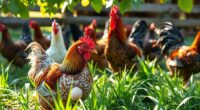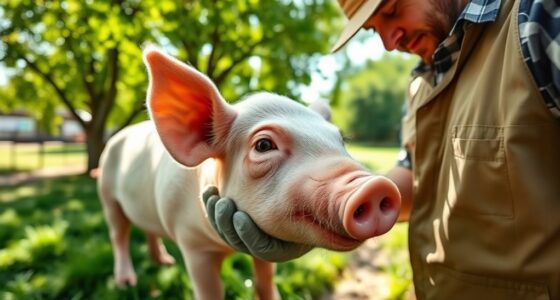To successfully breed cattle, you need to master heat detection and artificial insemination. Watch for signs like restlessness, mounting, and swollen vulvas to identify when your cows are in heat. Proper timing of AI during this fertile window enhances conception rates. Using tools like activity monitors or patches can improve detection. Correctly implementing these practices helps you improve herd genetics and results in healthier calves. Keep exploring these topics to boost your breeding success.
Key Takeaways
- Accurate heat detection is vital for timing artificial insemination effectively.
- Signs of heat include restlessness, mounting behavior, and vulvar swelling.
- Using heat detection aids like patches or activity monitors improves accuracy.
- Schedule AI during the optimal fertility window identified by heat signs.
- Combining genetic selection with proper heat detection enhances breeding success.

Have you ever wondered what goes into producing high-quality cattle? It all begins with understanding how to select the right genetics and manage the breeding season effectively. Genetic selection is fundamental because it determines the traits you’ll pass on to future generations, such as growth rate, meat quality, and disease resistance. When you choose superior sires and dams based on their genetics, you’re setting your herd up for long-term success. This process involves evaluating animals for desirable traits and making informed decisions to improve the herd’s overall quality. The breeding season, which typically occurs once or twice a year, is when you can maximize reproductive efficiency. Planning this period carefully guarantees that your cattle are in excellent condition for conception, and it helps synchronize calving, making management easier and more predictable.
Selecting the right genetics and planning the breeding season boosts reproductive efficiency and herd quality.
During the breeding season, you need to monitor your cattle closely to identify signs of heat, or estrus. Detecting heat correctly is vital because it determines the timing of artificial insemination (AI) or natural breeding. When a cow is in heat, she exhibits specific behaviors like restlessness, mounting other cows, and a swollen, reddened vulva. You’ll want to observe these signs consistently, especially during peak times, to catch her at the right moment for insemination. Accurate heat detection increases the chances of successful conception and reduces the number of services needed, saving time and resources. Implementing reliable heat detection methods can significantly improve your breeding success rate.
Artificial insemination is a powerful tool that allows you to utilize superior genetics without the need for maintaining a bull on-site. By coordinating AI during the identified heat window, you ensure that your cattle breed with the best possible sires, often from distant or proven lines. This method not only improves genetic quality but also reduces the risk of disease transmission and minimizes the physical challenges associated with natural breeding. To succeed, you’ll need to prepare your cattle beforehand, ensuring they are in good health and receptive. Proper timing is essential—inseminate too early or too late, and you risk missing the fertile window. Using heat detection aids, such as heat patches or activity monitors, can help improve accuracy.
Ultimately, managing genetic selection, understanding the breeding season, and practicing precise heat detection are key to successful cattle breeding. When you combine these elements with the strategic use of artificial insemination, you’re setting yourself up for a productive, genetically advantaged herd. This approach allows you to make the most of each breeding cycle, producing healthier calves with desirable traits that will benefit your operation for years to come.
Frequently Asked Questions
How Can I Improve Heat Detection Accuracy?
You can improve heat detection accuracy by using estrus synchronization and hormonal treatments, which help regulate and predict when cows come into heat. Keep a close eye for signs like mounting behavior or swelling and use tools like activity monitors or tail head markers to track changes. Combining these methods increases your chances of identifying ideal insemination times, leading to better conception rates.
What Are Signs of Silent Heat in Cattle?
Silent heat can slip past you like a ninja, showing no obvious signs. You won’t see typical ovulation signs or behavioral cues like mounting or restlessness. Instead, hormonal fluctuations happen quietly, leaving you guessing. You might notice subtle changes, but they’re easy to miss. Keep a close watch, use heat detection aids, and track your cows’ behavior carefully—silent heat sneaks in when least expected, making it a tricky but manageable challenge.
How Often Should AI Be Performed for Optimal Results?
You should perform AI every 12 to 24 hours during the breeding season for ideal results. Regular timing ensures better chances of successful conception. Incorporate genetic selection to choose high-quality sires, and monitor your herd closely to detect perfect heat periods. Consistent AI sessions improve fertility rates, especially if you track heat cycles accurately. This approach boosts genetic progress and helps you achieve better overall herd performance.
What Are Common Reasons for AI Failure?
Imagine a delicate dance halted unexpectedly—AI failure happens for reasons like poor heat detection, incorrect timing, or subpar semen quality. Genetic selection influences fertility, while disease management affects conception success. If you overlook these factors, your efforts falter. Ensuring accurate heat detection, proper timing, and good herd health helps prevent AI failures, making your breeding program more effective and productive.
How Can I Improve Fertility Rates in My Herd?
To improve fertility rates in your herd, focus on genetic selection by choosing high-quality sires with proven fertility traits. Guarantee proper nutritional management, providing a balanced diet that meets all nutrient requirements to optimize reproductive health. Regularly monitor heat detection and insemination timing, and address any health issues promptly. These strategies boost conception rates, leading to a more productive herd and better overall reproductive performance.
Conclusion
Mastering heat detection and artificial insemination can seem overwhelming, but once you get the hang of it, you’ll reveal the secret to breeding success that’s almost magical. Imagine transforming your herd into an unstoppable force of productivity, with calves arriving like clockwork and your farm thriving beyond imagination. With dedication and sharp instincts, you’ll soon wield the power to revolutionize your cattle operation, turning what once seemed complicated into a seamless, awe-inspiring process of agricultural mastery.










